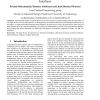Free Online Productivity Tools
i2Speak
i2Symbol
i2OCR
iTex2Img
iWeb2Print
iWeb2Shot
i2Type
iPdf2Split
iPdf2Merge
i2Bopomofo
i2Arabic
i2Style
i2Image
i2PDF
iLatex2Rtf
Sci2ools
INTERACT
2003
2003
Empirical Evaluation of Performance in Hybrid 3D and 2D Interfaces
: Experimental studies of spatial input devices have focused on demonstrating either the superiority of 3D input devices over 2D input devices, or the superiority of bimanual interaction over unimanual interaction. In this paper, we argue that hybrid interfaces that combine a 3D input device with a 2D input device have received little attention up to now and are potentially very useful. We demonstrate by means of an experimental evaluation that working with hybrid interfaces can indeed provide superior performance compared to strictly 3D and 2D interfaces.
| Added | 31 Oct 2010 |
| Updated | 31 Oct 2010 |
| Type | Conference |
| Year | 2003 |
| Where | INTERACT |
| Authors | Sriram Subramanian, Dzmitry Aliakseyeu, Jean-Bernard Martens |
Comments (0)

